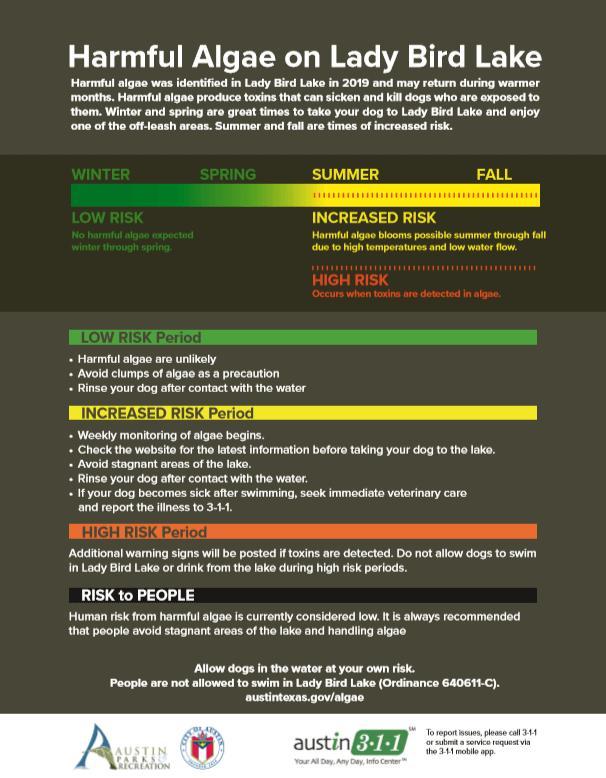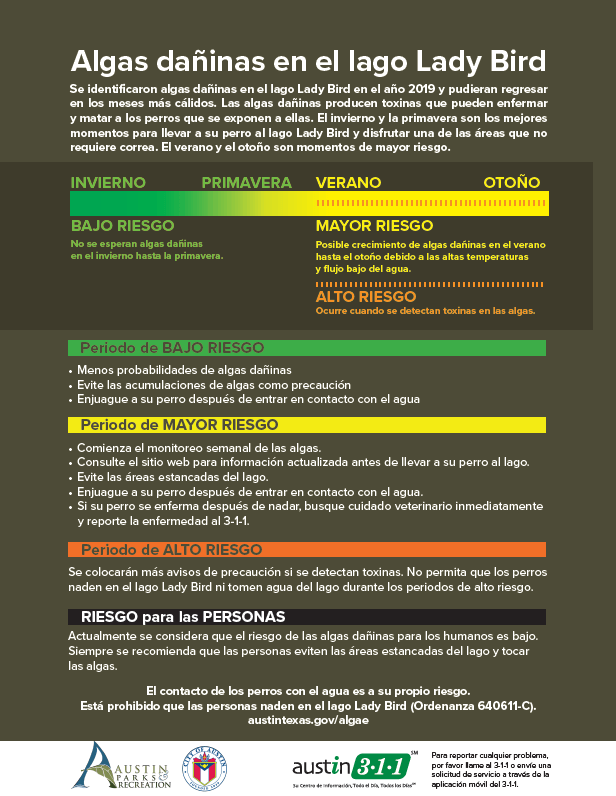Blue Green Algae LadyBird Lake
Lady Bird Lake – Algae ALERT
Information provided by Austintexas.gov
A harmful algae bloom occurs when cyanobacteria, also called blue-green algae, produce toxins. Lady Bird Lake experienced a harmful algae bloom in 2019, which sickened and killed several dogs. It’s possible another one may occur in 2020.
Current Status
July 1, 2020 – Risk is increased based on typical summer conditions. Weekly monitoring has begun. We observed no concerning algae on Lady Bird Lake on July 1, and average water temperatures had actually dropped a little from the previous two weeks.
3-Day Average Temperature and Flow
- Red Bud: 24.03 °C (75°F)
- Barton Creek: 22.58 °C (73°F)
- Vic Mathias Shores: 24.3 °C (76°F)
- Festival Beach: 26.28 °C (79°F)
- Flow: 501 cubic feet per second at Tom Miller Dam (average excludes weekends)
Lady Bird Lake continues to meet State of Texas contact recreation standards, which are based on bacteria levels.
Recommendations
The lake is at increased risk for harmful algae in the summer and fall, when water temperatures are warm and there is less flow through the lake. We recommend the following:
- Keep dogs away from floating mats of algae and stagnant areas of the lake.
- Rinse your dog after contact with the water.
- If your dog becomes sick after swimming, take your dog to a veterinarian immediately.
If you allow your dog to swim in Lady Bird Lake, you do so at your own risk.
Symptoms of Exposure
Dogs who ingest algae with this toxin could have a number of symptoms, including respiratory paralysis and death. Dogs can also be exposed to the toxin by licking algae from their fur. Look for these signs in your pet within minutes to hours of exposure:
- Excessive drooling, vomiting and diarrhea
- Foaming at the mouth
- Jaundice and hepatomegaly
- Blood in urine or dark urine
- Stumbling
- Loss of appetite
- Photosensitization in recovering animals
- Abdominal tenderness
- Progression of muscle twitches
- Respiratory paralysis
Risk for People
The risk to humans is currently low. The 2019 harmful algae bloom appears to have only affected dogs. The toxins were contained in the algae and not released into the water. It is always recommended that people avoid stagnant areas of the lake and handling algae. Remember that people are not allowed to swim in Lady Bird Lake (Ord. 640611-C).
Testing and Monitoring
Winter and Spring: We conduct monthly monitoring of temperature, flow and other metrics. The purpose of this monitoring is to detect long-term trends in the lake’s water quality. Although this testing does not include algae sampling, the results will indicate whether the risk for harmful algae is increasing.
Summer and Fall: We conduct weekly sampling of algae to identify species and the presence of toxins at four locations. Locations include Red Bud Isle, Barton Creek between Barton Springs and the lake, Vic Mathias Shores and Festival Beach. Testing may occur twice a week if conditions warrant.

Algae at Red Bud Isle on October 14.
Cause and Type of Algae
Blue-green algae are one of the earliest forms of life and are common worldwide. Keep in mind:
- There are many types of blue-green algae, but only some species can produce toxins.
- There are several different types of toxins possible.
- Even if a species is capable of producing toxins, that doesn’t mean it will always do so. Generally, harmful algae need warm water, low flow and high levels of nutrients.
Blue-green algae can be single cells spread throughout the water. When they form mats that are big enough to see, they usually look like dark green, slimy blobs. Mats can be on the bottom or floating on the top of the water. Blue-green algae are often mixed in with other types of algae.
We are not aware of any human or pet health problems from harmful algae in Austin prior to 2019. Zebra mussels, flooding during the fall of 2018 and climate change are potential contributing factors to the harmful algae bloom in 2019.
Drinking Water
Austin Water regularly tests algae levels on Lake Austin and Lake Travis near their intake pipes and has not seen levels of concern for drinking water. Currently, Austin Water does not use Lady Bird Lake as a source for drinking water.
Other Bodies of Water
Stock ponds have the highest risk for harmful algae. Most stock ponds are privately owned. Creeks, where water is cool and flowing, are less likely to have harmful algae. We are currently only monitoring Lady Bird Lake for harmful algae. However, we conduct routine water quality monitoring of creeks, Lake Austin and Lake Walter E. Long. There is more information about our monitoring programs in the related links section below.
We recommend avoiding water bodies that are warm and stagnant.



